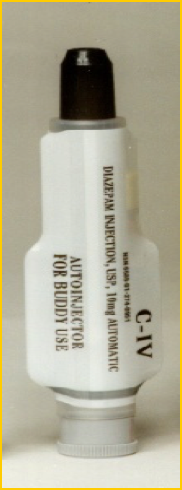Sarin and Other Substances: What You Need To Know?
The MESH Coalition recently hosted a Grand Rounds event in partnership with Eskenazi Health where presenter Dr. John Urbanetti discussed Sarin and other chemical substances and how prepared we are to effectively respond to their release as a weapon. Dr. Urbanetti is National and International expert on medical implications of and response to nerve agents, chemicals, and other weapons of mass destruction. Additionally, Dr. Urbanetti is a Consultant to the U.S. Army Medical Research Institute for Chemical Defense, as well as being a part of the faculty at Yale University Medicine and Pulmonary Diseases. This presentation was a great insight into Sarin and chemical substances that are affecting communities across the world.
Sarin - Intentional Release as a Weapon
Executive Summary
(12/8/17)
Timeline of modern chemical weapons use:
· 1915 - First major gas attack was used by Germany in WWI when they released chlorine gas, they were also the first to develop nerve agents
· 1925 - Geneva Protocol signed for the prohibition of gas and biological attacks
· 1900s - Mustard gas became a popular substance used in warfare
· 1980s - Sadam Hussein infamously used deadly chemicals and nerve agents as a weapon in the Iraq-Iran war, with an estimated 45,000 deaths by nerve agents
· 1993 - Sarin was banned and classified as a Schedule-1 Chemical by the Chemical Weapons Convention
· 1995 - Aum Shinrikyo, a Japanese doomsday cult, releases Sarin in Tokyo subway - killing 12 and over 5,500 developed symptoms and sought treatment at 278 healthcare facilities; most arrived at hospitals not by ambulance.
· 2013 - Sarin attack in Syria kills numerous innocent civilians and injures up to 1,000 more
· 2017 - Sarin attack in Syria kills 89 and injures 300. President Trump orders airstrike on Shayrat Air Base, the presumed source of the attack
Sarin Properties:
· Clear, colorless liquid (NOT NERVE “GAS”)
· Freeze / melt ~ - 56 º C
· Boil~ 147º C
· Tasteless with faint (fruity) to NO ODOR
· Volatility ~ Water
· Exposure most commonly respiratory
· Liquid & vapor both easily penetrate skin / clothing
Sarin Symptoms:
· VAPOR EFFECTS: Occur within seconds, peak within minutes, no delayed onset
· MILD exposure: MIOSIS (dim vision, eye pain) rhinorrhea, dyspnea
· MODERATE exposure: Pronounced dyspnea, secretions, nausea, vomiting, diarrhea, weakness
· SEVERE exposure: Immediate LOC, seizures, apnea, flaccid paralysis
Detailed Summary
Chemical warfare and terrorist tactics are starting to coincide with the use of substances that can bring great health risk to those exposed and the community health providers and responders that come in contact with them. Many nerve agents have been used throughout history, but Sarin has become a prevalent nerve agent because of the destructive affects it has against its victims. With the progressive advancements of technology, drone usage has become a weapon that can be used without the deployment of people. In terms of chemical warfare, Dr. Urbanetti believes that the number 1 nemesis for chemical delivery is the drone. Additionally, with Sarin being relatively easy to make compared to other complex chemical agents, it is of great concern to the public because of its past history of harm and the types of groups that are starting to test their ability to make and use it.
The Tokyo subway attack is a prime example of how Sarin could cause a massive medical surge; 278 healthcare facilities were involved in treating patients. There were more than 5,500 people that developed symptoms; most of which presented by other modes of transportation and not by ambulance. It is imperative that healthcare and public safety organizations prepare for cases like these by working together using a community approach, with the goal of reducing the pressure and chaos brought on by the event and the subsequent medical surge on healthcare facilities.
Treatment of Nerve Agent Exposure
The first and foremost important step to treating someone who has been contaminated is to start the decontamination process. This is an extensive and detailed process that must be done carefully in order to not further contaminate other responding individuals. First, it is imperative that anyone treating a contaminated person should wear appropriate personal protective equipment to avoid exposure. This is normally done by removing contaminated clothing, thoroughly washing body and hair with soap and water, and flushing eyes with large amounts of water or saline solution. Contaminated clothing should be double-bagged after removal to prevent further exposure. contaminated clothing, thoroughly washing body and hair with soap and water, and flushing eyes with large amounts of water or saline solution. Additionally, the responder should maintain adequate circulation. If trauma is suspected, maintain cervical immobilization manually and apply a decontaminable cervical collar and a backboard when feasible. Furthermore, they should apply direct pressure to stop arterial bleeding, if present. Nerve agents can be treated using Atropine, +2-PAM, and Diazepam, as pictured below.
The pictures above are autoinjector treatments for nerve agents, such as sarin.
Resources
Centers For Disease Control and Prevention. (2014, October 21). Toxic Substances Portal - Nerve Agents (GA, GB, GD, VX). Retrieved December 08, 2017, from https://www.atsdr.cdc.gov/MMG/MMG.asp?id=523&tid=93
Kimball, D., & Davenport, K. (n.d.). Fact Sheets & Briefs. Retrieved December 08, 2017, from https://www.armscontrol.org/factsheets/Timeline-of-Syrian-Chemical-Weapons-Activity
New York State Department of Health. (n.d.). Facts About Nerve Agents. Retrieved December 08, 2017, from https://www.health.ny.gov/environmental/emergency/chemical_terrorism/nerve_agents_tech.htm
Ontario Medic. (n.d.). A Look at Sarin. Retrieved December 8, 2017, from http://ontariomedic.ca/2017/04/14/a-look-at-sarin/
Urbanetti, Dr. John. “Sarin in Syria.”, MESH Coalition Grand Rounds, 5 December 2017, Eskenazi Health Center-Pecar, Indianapolis, IN. 6940 N Michigan Rd, 46268.





